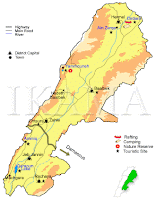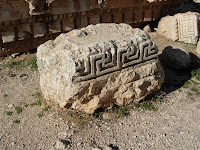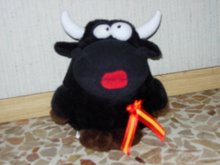
We were supposed to call a taxi driver to bring us in Baalbek, but as proof of extreme lebanese kindness, we found two friends which offer to bring us there by car (youhouuu!) to that city, 85 km East from Beirut, the most important center of Bekaa Valley. The road to Bekaa is quite good, except some deviation you have to take because of wasted bridges

Bekaa is a fertile valley in Lebanon and Syria, situated between the Mount Lebanon to the west and the Anti-Lebanon Mountains to the east. From the 1st century BC, under Roman domain, Beqaa Valley served as a source of grain for the Roman province of Syria. Today the northern end of the valley is used primarily as grazing land by pastoral nomads, while the southern one supports crops of wheat, corn, cotton, and vegetables, with vineyards centered around Zahlah. Note: the valley is said also to produce hashish and cultivates opium poppies, which are exported illegally...Such "products" find their origin since roman rule, as we'll see in Baalbek site.

Zahle is the largest city in Beqaa Valley. It lies just north of the main Beirut–Damascus highway, which bisects the valley. My friends told me that most of Zahle's residents are Christian Arabs (Armenians, Greek Catholics, Maronites) but due to the wars and the strong presence of the HA in the valley, many of them have left the Bekaa for the coastal cities of Lebanon or emigrated abroad. On our way, we passed through villages where traditions want that meat is still "freshly" barbecue served :)

but i have to say i had the best brekfast ever had: not croissant, not jam, but delicious Bekaa's dairy products. Khabbaz Markouk, which is a thin kind of bread (it seems "piadina"), with fresh creamy labne (yogurt) spread inside: i had a sweet version (with honey inside), and a salty one with pikles (Kabis Khyar), tomatoes and olives: SIMPLY GREAT!!! It was really a shame for me not to taking a bag fullfil with those products, i just bought a medium recipe of Shankleesh, an appetizer(mezze) made from cow-yogurt(Laban),slightly acid (Arisheh), drained in cheesecloth(Labneh) and finally warpped with herbs or spices (i choosed mint); subsequently, the new mixture produced is turned into small balls and are exposed to the sun to let it dry out slowly in order to keep the balls quite soft. I swear they are fabulous with our durum wheat bread and dried tomatoes, yummy!

Not far from Deir-Al Ahmar there's the Church of Saydet Bechweit, with a statue of a Virgin which is said to have cried in the past several times


Known as Heliopolis during the Hellenistic and Roman times (Madina as-Shams in arabic, Sun City), "Baalbek, with its colossal structures, is one of the finest examples of Imperial Roman architecture at its apogee," UNESCO reported in making Baalbek a World Heritage Site in 1984. The temple complex of Baalbeck is made up of the Jupiter Baal (Baal=God, Baalbek=God of Bekaa) Temple and the Bacchus Temple adjacent to it. A short distance away is the circular structure known as the Temple of Venus. Only part of the staircase remains of a fourth temple dedicated to Mercury, on Kheikh Abdallah hill.
First of all, a good news: as my "mission" here was to check the status of the site, as several times i heard from newspapers that Israel bombed Baalbek as well, well, now i can say that there's no evidence of any damage caused by last summer bombing, and this was also confirmed by the men i met in the site. However, it has been reported by UNESCO that during the conflict, vibrations caused by bombs damaged the ruins.

I'm going to show you some picture, after that you'll get by yourself the extreme importance of the site and maybe keep astonished asking why, when at school, any professor of Art History told us about Baalbek existence, although Baalbek could have the same (or much more) importance of archeological sites like Paestum, Agrigento or Athens! Am i wrong? just take a look.
The first view the visitor has of Baalbeck is the six Corinthian columns of the Great Temple thrusting 22 meters into the skyline. Built on a podium seven meters above the Court, these six columns and the entablature on top give an idea of the vast scale of the original structure. The complex of the Great Temple has four sections: the monumental entrance or Propylaea, the Hexagonal Court, the Great Court and finally the Temple itself, where the six famous columns stand.
The Propilea, with an entrance structure fronted by 12 granite columns

The Hexagonal Forecourt, with 30 granite columns originally supporting the entablature


The Great Court, built in the 2nd century A.D., contains the main installation of the cult. Two huge structures stand in the center of the Great Court: a restored sacrificial altar and a tower with only the lower courses remaining, but these structures were destroyed when a Christian basilica was built on the site at the end of the 4th century. Surrounding the Court, in front of the exedrae, was an 84-column Corinthian colonnade of Egyptian granite. A photo shows also how opium was "famous" among romans as well.



Temple of Jupiter measures 88x48 meters and stands on a podium 13 meters above the surrounding terrain, it is reached by a monumental stairway. Originally surrounded by 54 external columns, most of these now lie in fragments on the ground. The dedication of the present temple ruins, the largest religious building in the entire Roman empire, dates from the reign of Septimus Severus, whose coins first show the two temples and in commemoration Severus conferred the rights of the jus italicum on the city. Today, only six Corinthian columns remain standing. Eight more were disassembled and shipped to Constantinople under Justinian's orders, for his basilica of Hagia Sophia.



The Little Temple or the "Temple of Bacchus", constructed during the first half of the 2nd century A.D., it has been remarkably well preserved. It was apparently consecrated to a mysterious and initiatic cult centered around the young god of Baalbeck. Wine and other drugs, such as opium, may have been used by the worshipers and it was the carvings of grapes and poppies on the main door jamb and some carved Bacchic scenes, which suggested the temple's identification with Bacchus Dionysus. It is enriched with refined reliefs and sculpture, included Antonio and Cleopatra (last pic), to remind people which consequences leads a "wrong" love.





The Round Temple or the "Temple of Venus" (Ashart) was built in the 3rd century A.D.but during the Byzantine period it was converted into a church dedicated to Saint Barbara, who is the patron saint of Baalbeck

So now, do you feel like visiting it ???



Nessun commento:
Posta un commento